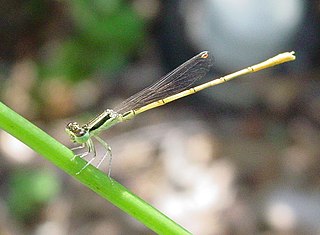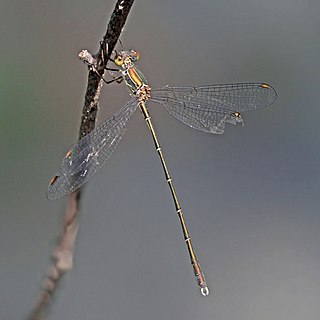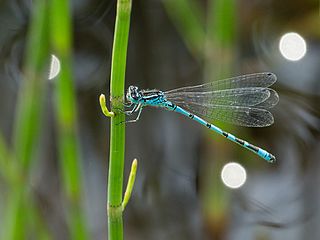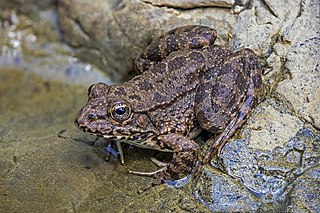
Odonata is an order of predatory flying insects that includes the dragonflies and damselflies. The two groups are distinguished with dragonflies usually being bulkier with large compound eyes together and wings spread up or out at rest, while damselflies are usually more slender with eyes placed apart and wings folded together along body at rest. Adult odonates can land, but rarely walk.

Damselflies are flying insects of the suborder Zygoptera in the order Odonata. They are similar to dragonflies but are smaller and have slimmer bodies. Most species fold the wings along the body when at rest, unlike dragonflies which hold the wings flat and away from the body. Damselflies have existed since the Jurassic, and are found on every continent except Antarctica.

The black-tailed skimmer is a dragonfly belonging to the family Libellulidae.

The red-veined darter or nomad is a dragonfly of the genus Sympetrum.

The common darter is a dragonfly of the family Libellulidae native to Eurasia. It is one of the most common dragonflies in Europe, occurring in a wide variety of water bodies, though with a preference for breeding in still water such as ponds and lakes. In the south of its range adults are on the wing all year round.

The citrine forktail is a damselfly of the family Coenagrionidae.

Somatochlora, or the striped emeralds, is a genus of dragonflies in the family Corduliidae with 42 described species found across the Northern Hemisphere.

The wildlife of Cyprus includes its flora and fauna and their natural habitats. Cyprus has a rich flora and a diverse fauna albeit with relatively few mammals. Like most modern countries, the natural habitats in Cyprus have been steadily disappearing, currently retaining only 20% of its original habitat due to rapid urbanization, usage of forests for commercial purposes, tourism and various other reasons. One of the features of Cyprus' habitats is the wild and sharp differences in elevations and habitats on the island as well as climate, all of which supply a diverse habitat for an array of fauna and flora. Terra Cypria was established as a trust in 1992 to conserve the Cypriot environment and its biodiversity.

Chalcolestes parvidens, formerly Lestes parvidens, is a damselfly of the family Lestidae. It has a metallic green body and at rest it holds its wings away from its body. Its common name in English is the eastern willow spreadwing.

Sympecma fusca, the common winter damselfly, is a damselfly a member of the Lestidae and related to the emeralds or spreadwings.

The eastern amberwing is a species of dragonfly in the family Libellulidae. It is very small, reaching a total length of no more than 25 millimetres (0.98 in). The males have orange or amber wings. Both sexes have a red pterostigma.

Eastern forktail is a member of the damselfly family Coenagrionidae.

Chalcolestes viridis, formerly Lestes viridis, is a damselfly of the family Lestidae. It has a metallic green body and at rest it holds its wings away from its body. Its common name is the willow emerald damselfly, the green emerald damselfly, or the western willow spreadwing. It has an elongated abdomen and pale brown spots on its wings and resides in areas of still water with overhanging trees.

Onychogomphus forcipatus, the small pincertail, green-eyed hooktail, or green-eyed hook-tailed dragonfly, is a species of dragonfly belonging to the family Gomphidae.
Odonata are insects with an incomplete metamorphosis (hemimetabolous). The aquatic larva or nymph hatches from an egg, and develops through eight to seventeen instars before leaving the water and emerging as the winged adult or imago.

Brachythemis impartita, the Northern banded groundling, is a species of dragonfly, a skimmer from the family Libellulidae from central and northern Africa, its range extending into southern Europe and the Middle East. It was previously considered to be conspecific with B. leucosticta.

Coenagrion ornatum, or, the ornate bluet, is a species of damselfly from the family Coenagrionidae distributed across a large part of Europe and Western Asia.

The Persian damselfly or Dumont's bluetail is a damselfly, belonging to the family Coenagrionidae.

Pelophylax cypriensis, the Cyprus frog or Cyprus water frog, is a species of frog in the family Ranidae. It is endemic to Cyprus. It is widespread in Cyprus, with the highest density in the Troodos area, the most humid part of the island. It can live in both stagnant and brackish water, including small pools, streams, and ditches.

Orthetrum ransonnetii, the desert skimmer or Ransonnet's skimmer, is a wide spread dragonfly species from Africa and the Middle East.




















